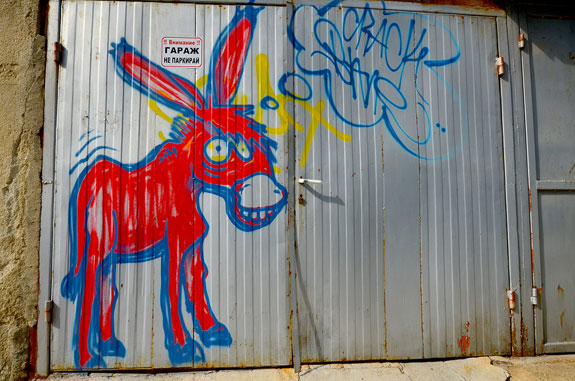 It was just after eight in the morning. I had been on an overnight flight across three time zones. My mind was fuzzy with fatigue and eyes drowsily droopy. But shut they would not.
It was just after eight in the morning. I had been on an overnight flight across three time zones. My mind was fuzzy with fatigue and eyes drowsily droopy. But shut they would not.
I grabbed my bags and headed for the train station. A few minutes after rolling out of the station, my sight was assaulted by vivid color. For the next mile, the earth-retaining walls and the back walls of buildings next to the railway tracks were covered with graffiti. And I wondered, if graffiti was this elaborate here, why was there none in the airport arrival lounge?
At every train stop, the same scenario repeated itself about a mile into the station and another out of it. An hour later, we rolled into my destined station. It was the same as all the others. As soon as I stepped out onto the street, I quickly surveyed all the surrounding building for any signs of graffiti. None, zilch, nada… I wondered, “Why?”
There was clearly a lot of artistic acumen in the canvas of graffiti that was laid out on those walls. I could see the intricate thought. However, I also had a deep sense of the violent despair in the soul of the graffitist, emptiness.
The words and images were a depiction of a lost hope. It was like those behind the graffiti had ganged up to send a silent challenge and a plea to be pointed in the right direction. What if their talent was harnessed to improve the aesthetics of public places?
Back home, two separate incidents helped me understand why ganging up emerges when true leadership fails. When a leadership vacuum occurs, gangs slowly start to form and thrive.
Stop, Police!
I had a conversation with a senior police officer as he sat in the passenger seat of my car. Where I come from, it isn’t uncommon for a police officer to flag you down for a lift. They sometimes don’t have sufficient resources at their disposal. It was then that I spotted the driver of a commuter bus commit a traffic offence.
When I asked the police officer why this was so rampant, his response left me gutted. “You see,” he sighed in resignation, “If I arrest this guy, I’ll waste a good part of my day. The paperwork is time-consuming. When he goes to court, he’ll only have to pay a small fine and is back on the road a few hours later. So why bother? No one has been injured anyway.”
This special breed of gangs have emerged because of a lack of leadership in the judicial system and weak enforcement of laws. The traffic-law-breaking gangs have grown to endemic levels; just because a leader abdicated their role to put in place the right policies and protocols.
Checked Out
The second was a series of events at one of my former workplaces. Discord was evident everywhere. The quality of work had deteriorated. By the time I left, about half the work force was coming to the office an average of thirty minutes past the official reporting time. Some would saunter in as much as an hour late and act like nothing unusual had occurred.
About half the workforce was showing up but was checked out. They had formed an alliance; a gang of employees who did the bare minimum work that reflected the quality of the leadership.
Something unfortunate began to happen. A few hard-working valuable employees were unsettled by this mediocre gangs that had formed. They were frustrated as delivery of their results depended in part to their colleagues who had already “checked out.”
Finally, some of these valuable people started to check out too. They did not join the gangs of mediocrity; they left the organization for good!
Three ‘must-dos’ for Leaders
First, people have a deep desire to be led in an authentic way. You can’t expect goodness from people if you don’t extend it to them first. “If we have a good heart and concern for others, our actions will be positive.” ~Dalai Lama
Secondly, start small before things snowball on you. Assess your habits as a leader. If you show up late for work late, your followers will follow suit. It doesn’t matter whether you are a morning person or not. “Leadership is an action, not a position.” ~Donald McGannon
Third, listen to the pulse of workers who churn out quality work effortlessly. Protect and influence them to create gangs of excellence that grow the organization’s vision. “Leading an organization is like frying a small fish. You spoil it with too much poking.” ~from the Tao the Ching
Which gangs would you rather lead? I’d love to read your comments!

 Many definitions of leadership involve the word INFLUENCE. “Leadership is influence, nothing more, nothing less.” (John Maxwell) What does influence have to do with leadership, though? A leader needs to do two things: build or maintain relationships, and get things done.
Many definitions of leadership involve the word INFLUENCE. “Leadership is influence, nothing more, nothing less.” (John Maxwell) What does influence have to do with leadership, though? A leader needs to do two things: build or maintain relationships, and get things done.